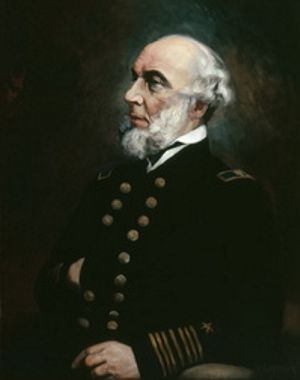
He took command of the sloop Dale in May 1847 and participated in the capture of Mazatlán and Guaymas. Badly wounded in the latter engagement, he was returned home as an invalid home in June 1848. He was subsequently assigned to the Boston Navy Yard, where he remained until 1861.
Captain Selfridge commanded Mississippi, flagship of the Gulf Squadron, on blockade duty off Mobile and off the passes of the Mississippi. His old wound forced him to relinquish his command in February 1862, however, and he served ashore until retiring in 1866.
Rear Admiral Selfridge died at Waverley, Massachusetts 15 October 1902.

Source: US Navy Art Collection.
Rear Admiral Thomas O. Selfridge, Jr. by M. Hartman.
At the beginning of the Civil War, he helped with efforts to destroy the untenable Norfolk Navy Yard; and he then escaped from that burning and beleaguered base in Cumberland, helping to save the sloop of war for the Union Navy. He participated in the capture of the Hatteras forts and was on board Cumberland on 8 March 1862 when she was sunk by Confederate ironclad, Virginia. He briefly commanded Monitor after Lieutenant John L. Worden was wounded. He also commanded Alligator, an experimental submarine, in testing operations based at the Washington Navy Yard.
In August, Selfridge joined the Mississippi Squadron, and subsequently commanded Cairo and Conestoga when those ships were sunk in action. Late in the war, he returned to the Atlantic where he commanded Huron in the attacks on Fort Fisher; and he participated in the ensuing bombardment of Fort Anderson and the capture of Wilmington, North Carolina.
His postwar service included command of Nipsic, Enterprise, and Omaha—the last two on the Asiatic Station—and duty as Commander in Chief of the European Squadron from 1895 to 1898. He retired on 6 February 1898 and died on 4 February 1924.